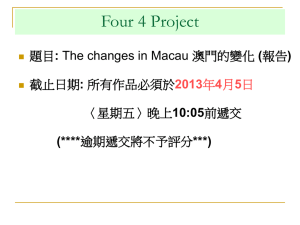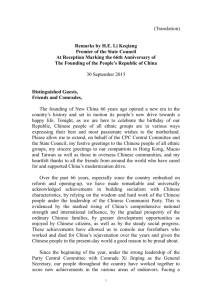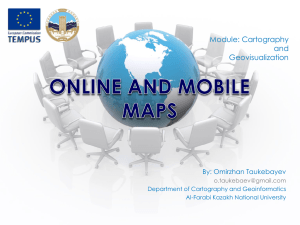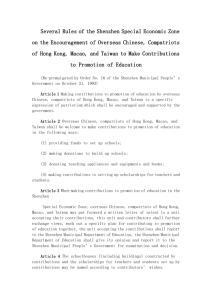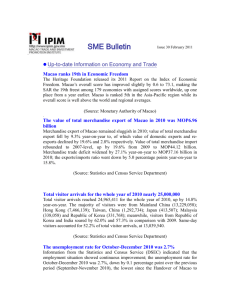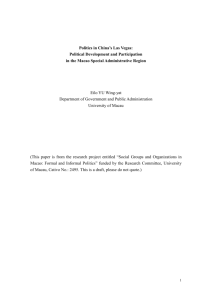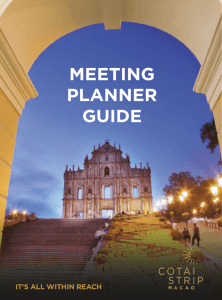Overview of the Canton System Era and of China Trade Art
advertisement
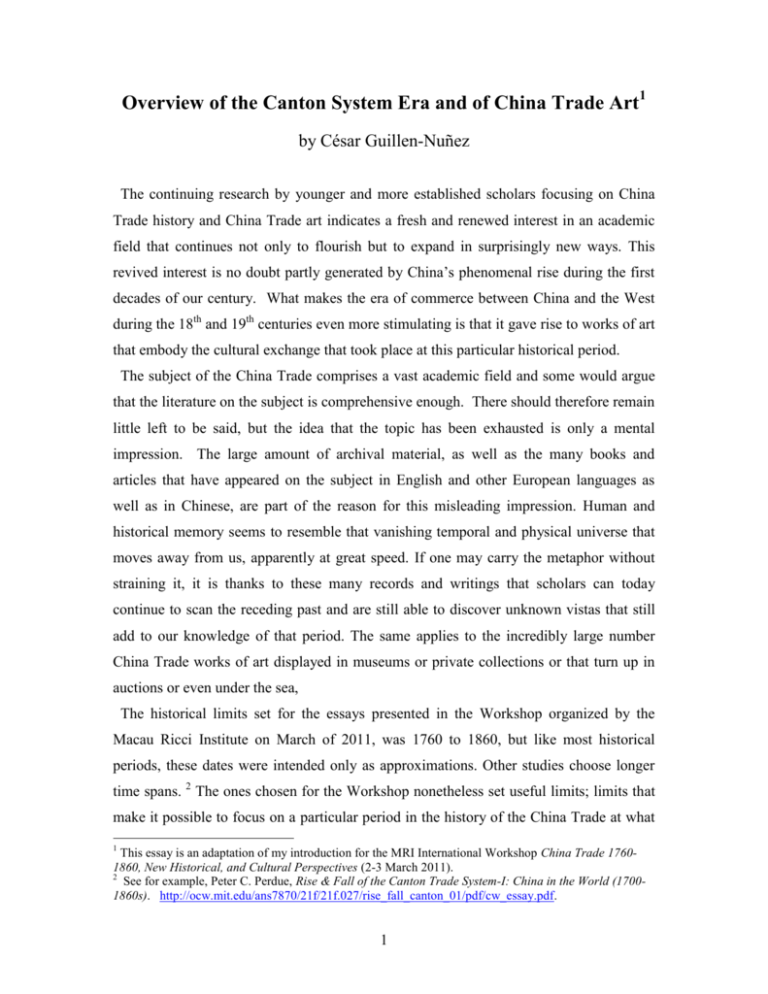
Overview of the Canton System Era and of China Trade Art1 by César Guillen-Nuñez The continuing research by younger and more established scholars focusing on China Trade history and China Trade art indicates a fresh and renewed interest in an academic field that continues not only to flourish but to expand in surprisingly new ways. This revived interest is no doubt partly generated by China’s phenomenal rise during the first decades of our century. What makes the era of commerce between China and the West during the 18th and 19th centuries even more stimulating is that it gave rise to works of art that embody the cultural exchange that took place at this particular historical period. The subject of the China Trade comprises a vast academic field and some would argue that the literature on the subject is comprehensive enough. There should therefore remain little left to be said, but the idea that the topic has been exhausted is only a mental impression. The large amount of archival material, as well as the many books and articles that have appeared on the subject in English and other European languages as well as in Chinese, are part of the reason for this misleading impression. Human and historical memory seems to resemble that vanishing temporal and physical universe that moves away from us, apparently at great speed. If one may carry the metaphor without straining it, it is thanks to these many records and writings that scholars can today continue to scan the receding past and are still able to discover unknown vistas that still add to our knowledge of that period. The same applies to the incredibly large number China Trade works of art displayed in museums or private collections or that turn up in auctions or even under the sea, The historical limits set for the essays presented in the Workshop organized by the Macau Ricci Institute on March of 2011, was 1760 to 1860, but like most historical periods, these dates were intended only as approximations. Other studies choose longer time spans. 2 The ones chosen for the Workshop nonetheless set useful limits; limits that make it possible to focus on a particular period in the history of the China Trade at what 1 This essay is an adaptation of my introduction for the MRI International Workshop China Trade 17601860, New Historical, and Cultural Perspectives (2-3 March 2011). 2 See for example, Peter C. Perdue, Rise & Fall of the Canton Trade System-I: China in the World (17001860s). http://ocw.mit.edu/ans7870/21f/21f.027/rise_fall_canton_01/pdf/cw_essay.pdf. 1 was arguably its greater period of commercial and artistic activity. They mainly delineate the heyday of the Canton System (1760-1842), a system that also came to include what is referred to as the Old China Trade (1783-1844) in U.S. history. The period chosen certainly predates the coming of an age when trade was imposed on China and Japan by Western powers and one should also be aware of the fact that included in the cut-off date of these time limits is the final demise of the Canton System’s heydays. With the 1842 Treaty of Nanjing five other Chinese ports were opened to the British and Hong Kong was ceded to Great Britain. Even then, Canton never quite lost its old allure and China’s plight did not acquire the tragic dimensions it would after 1860. It could be argued that the century or so that the mentioned dates frame was a special era that in some important respects is in fascinating contrast to the periods that preceded and followed it. That which preceded it in China witnessed the last phase of the troubled Ming Dynasty and the rise of the Qing. Qing Dynasty China is described by contemporary Chinese chroniclers living at the time, as well as by Western scholars currently researching the period, as a land of comparative prosperity and peace3. As for the Western merchants who sought commerce with it, they came for a world where some of the most advanced trading and ideological concepts in history had evolved, including the European and the American Enlightenment. What followed this more stable epoch in China was once again a return to greater discord––nor all caused by Europeans–– culminating in the destruction of the Yuan Ming Yuan (圓明園) in 1860. It is because of these contrasts that the old Canton System may appear to emerge from the pages of history with a gentler glow. However, this is only so by comparison. It is certainly true that the traditional trade in tea, porcelain and other commodities now flourished, but so did the increasing demand for opium and its opportunistic trade.4 Whatever its shortcomings, it was during this period that Western traders still largely followed at least some of the time-honoured practices of trading and it was at this time that modern 3 Frederic Wakeman Jr., “High Ch’ing: 1683-1839”, in Modern East Asia: Essays in Interpretation, New York, Harcourt, Brace & World, 1970, pp. 1-28. 4 The literature on the subject is vast; see more recently, Jonathan Goldstein, “A Clash of Civilizations in the Pearl River Delta, Stephen Girard’s Trade with China, 1787-1824, in Paul A. Van Dyke ed., Americans and Macao: Trade, Smuggling, and Diplomacy on the South China Coast, Hong Kong University Press, 2012, pp. 33-48. Paul A. Van Dyke, “Smuggling Networks of the Pearl River Delta before 1842”, op. cit., pp.49-72. 2 Western concepts of free trade were introduced to East Asia. It is therefore understandable that the period has also been described by some historians as an age of partnership between Asian and European country traders.5 From a perhaps biased art-historical perspective, what makes the Canton system period a true golden age is the art emerging from Chinese studios and workshops at the time. Although Chinese export items continued to be produced in great numbers during the second half of the 19th century, it was the preceding century which saw the production of many of the finer works of export art that have come to define the art of the China Trade today. Items of trade apart, the creations of independent, professional Western and Chinese painters active in the port cities of southern China, painters such as George Chinnery, Lamqua, Auguste Borget and others of the school, also form one of the essential component of that golden age. The works of art that were discussed during the MRI Workshop can be divided into two main groups. One consisted of the drawings and paintings of Western artists who often served in merchant ships or whose professional interests and hobbies––not unlike today’s photojournalists––comprised documenting the sights of Macao, Canton, Hong Kong and surroundings. Patrick Conner, one of the leading experts of China Trade painting, looked at the examples of William Alexander, draughtsman to the 1792-1794 Macartney Embassy to the Qing court, and of Thomas and William Daniell. The studies by Jonathan Wattis and William R. Sargent showed the impact that travel in southern China could have on Westerners, old or young. This may be seen in the majestic architectural drawings of Sir William Chambers and the charmingly naïve sketches of an American boy––with an evident interest in architecture–– living in Macao and Hong Kong, the latter obtained from Salem’s Peabody Essex Museum, Salem, Ma., and presented in the Workshop for the first time. William Shang’s PPT enlightened us about the rare 19th 5 See The Age of Partnership: Europeans in Asia Before Dominion, Edited by Blair B. Kling and M. N. Pearson. Honolulu: The University Press of Hawaii, 1979. Also, H. R. C. Wright review of this book in, The Journal of Economic History, Vol. 39, Issue 4, pp. 1053 -1054. 3 century G. E. Morrison collection of export paintings and other works of art, a collection now carefully housed in Tokyo’s Oriental Library, whose precious holdings include works by Chinese China Trade painters and William Alexander. The other main group consists of works of art and craftsmanship by Chinese artists produced to satisfy a growing Western demand that had evolved with the vogue for Chinoiserie, an imaginary vision of Cathay to which well-to-do Westerners on either side of the Atlantic could escape in their rococo salons. Winnie Wong presented a paper that in an unusual and originally way considered the production-line method existing in the Chinese studio of Lam Qua and other factory painters, thus posing provocative questions about the nature of aesthetics and of art. Less fanciful and more scientific in character were the sensitive botanical drawings by Cantonese artists discussed by Ching May-Bo. Jiang Yinghe’s presentation ingeniously introduced us to the end of the Canton System by discussing the process of creation of an American garden in front of the foreign factories in Canton through a chronological study of Chinese export paintings depicting the Western factories. Characteristically, in a paper that considered both the trade and its art, Paul A. Van Dyke meticulously combed through lists and documents for the names of Chinese artists in less studied sources and came up with fascinating new data. One of the most significant aspects of the period is the emergence of the East India Companies from the more northern parts of Europe, such as the Dutch, the British, Swedish, Danish and the French. The lives of the members of these Companies, who worked and resided in factories in Canton and Macao, can provide us today with rare glimpses of life in the days of the Canton System. The essays by Lisa Hellman and Bai Limin dealt with members of the Swedish and British factories. That by Lisa Hellman focused on three members of the Swedish East India Company, the third of which was the great historian of Macao, Sir Anders Ljungstedt. In her study Bai Limin discussed the short textbook for children written by the great Protestant missionary Robert Morrison. In a simple but significant way Morrison’s small book exemplifies one of the more positive aspects of the impact of Western civilization on China, India and the East. The Chinese counterpart of these foreign factory members were the Hong merchants. The carefully researched essay by Wei Peh-ti told us about the 19th century Qing-appointed 4 Chinese merchant-administrators, charged with the task of supervising foreign merchants through several historic court cases. Canton System merchants were for the most part content to trade and return home rich. The same was true of traders from the newly independent American colonies. After the 1775 American War of Independence––what the British perhaps prefer to call the American Revolution––American merchants arriving in China from 1784 onward were at first occupied mainly with purchasing and exchanging goods. These younger breed of merchants had not altogether displaced those that had previously arrived with the old superpowers that had pioneered trade in the region. Spanish traders were still active in Manila and elsewhere; indeed, the old Spanish flag can still be seen proudly waving in paintings of the thirteen Western factories in Canton. Portugal, naturally, had Macao. Rogério Miguel Puga, in one of the first and more thought-provoking papers presented at the Workshop gave us a much-needed nudge that awakened us to Macao’s importance for the British community and for the other East India Companies in general. Yet one is also indirectly reminded by other scholarly writings and more popular publications of how little Portugal and Spain had begun to matter. We need only leaf through a book such as Peter Gay’s The Age of Enlightenment to get an idea of how history had turned. In Gay’s book one may see attractive illustrations representing the main European cities of the Age of the Enlightenment. 6 Those that were central to the age, such as Edinburgh, London and Paris, are illustrated of course. Amsterdam, Vienna, Weimar, Milan and Florence in Italy, and even St. Petersburg in Russia also appear. Alas! Nowhere to be seen are any of the main Iberian cities in Europe or the Americas––not even Madrid or Lisbon. This is always a great disappointment, but one does have to admit that by the time that the Canton System was in full sail, Spanish and Portuguese carracks were slowly fading and receding into the fog of history. Portugal’s Carreira da India and Spain’s Galéon de Manila, with all that may be meritorious or odious about these international seaways, had already become secondary. 6 Peter Gay, The Age of Enlightenment (Great Ages of Man Series), New York, Time-Life, 1966. Enlightenment cities illustrated on pp. 8-9 (unnumbered). 5 Unfortunately, the period had more than its share of wars that were devastating Europe and the Americas. In October of 1795 Napoleon Bonaparte, then a brilliant but ambitious French artillery commander in his twenties, effectively put an end to the French Revolution by quashing a rebellion in the streets of Paris. The following year he invaded Italy, the first of his many military conquests.7 Soon the dawn of the Napoleonic era would initiate a new order in world history. During the Canton System days Macao enjoyed a local history that is particularly engrossing. At its start Dom José I sat on the Portuguese throne and the Marquis of Pombal ruled. In England a third Hanoverian king had ascended the throne as George III, and it is this enlightened monarch who would send the mentioned embassy headed by Lord Macartney to the Qing court. This famous envoy would later stop at Macao on his way home. The city would also play host to several lavish Portuguese embassies, as well as witness the expulsion of the Jesuits in 1762. Later and typically for the history of Portugal and its 19th century overseas colonies, Macao was in great turmoil due to an 1822 revolt led by local liberals, offshoots of Portugal’s Liberal Party, a revolt that came to naught. More important for the history of Macao was that it became the place of residence for Western traders and their families during the off-season from trading in Canton. This is therefore a period rich in historical moments and historical figures for the territory. Here one need only bring to mind other fascinating individuals whose names are connected to its history, such as Lord William Amherst, Commissioner Lin Zexu, Ambassador Caleb Cushing and the 1844 Treaty of Mong Ha, Sir Anders Ljungstedt, Robert Morrison, Harriet Low, etc., etc., and even Napoleon Bonaparte, who is significant for Macao because of the Napoleonic Wars to which reference has been made. As regards Emperor Napoleon, after the Battle of Waterloo he was demoted by the British to General Napoleon and exiled to the island of Saint Helena. His tomb in this isolated volcanic island was visited in 1834 by the mentioned American diarist Harriet Low. She writes in her diary, in the typical Romantic prose of the period that by this time had evolved in the West, “It was indeed a time for reflexion” (characteristically for the 7 Paul Johnson, Napoleon, Phoenix, London, second impression 2004, pp. 28-35. 6 age, here she uses the French word, as she had been learning Spanish and French while living in Macao). She continues: “ The tomb of the great man of whose fame the world knows enough, is situated on the side of the mountain in a most quiet and delightful spot … There is not a letter upon the [grave] stone, to say who or what lies there … It is a most enchanting spot. But far too quiet for the spirit of such a man as rests here … for how could he reflect upon his career, in this lone and desolate place.”8 Harriet Low’s genteel musings have the power to evoke for us today an era rich in art and literature and its approaching end, the era, in fact, that formed the historical framework for the papers presented in the MRI Workshop. I would like to conclude this introductory overview by pointing out that a few of the researchers who would have participated in the workshop could not do so for health and other reasons, and thus what could have been important contributions are now lacking. The absence of Dr. Valery Garrett’s researches is much regretted. Mr. Geoffrey Bonsall, the respected China Trade scholar, who was one of the very few world experts on the Gurney system of shorthand used by the painter George Chinnery, unfortunately passed away recently. With his usual camaraderie, he would have been happy to share his knowledge; he will be sorely missed. The Macau Ricci Institute is also very grateful not only to those scholars who took part in the China Trade’: Merchants and Artists (17601860) Workshop, but also to those who generously chaired its four sessions, namely, Dr. Stephen Davies, of the Hong Kong Maritime Museum; Mrs. Grace Lei Lai-Kio of the Macau Museum; the China Trade Historian Mr. Robert Nield, and last but not least, Fr. 8 Lights and Shadows of a Macao Life: The Journal of Harriett Low, Travelling Spinste, Woodinville WA, 2002. . 7 Artur Wardega, S.J., Director of the Macau Ricci Institute, as well as the staff of the Institute. César GUILLEN-NUNEZ is Research Fellow at the Macau Ricci Institute and until recently also Book Review Editor of the MRI’s Chinese Cross Currents quarterly. He has an M.Phil. (University College London), an M.A. (Uni. of Penn.) and a B.A. Hons. (Courtauld Institute of Art), all in the History of Art, with a specialization in Latin American, Spanish and Portuguese Colonial art and architecture of the Baroque period. The latter led him to the Jesuits as pioneers in the cultural East-West exchange. He began his professional career as Assistant Curator of China Trade and Contemporary Art at the Hong Kong Museum of Art, but later moved to Macao, where he was Deputy Curator and Acting Curator at the Luis de Camões Museum. He has written several books and numerous articles and art reviews. His books include: Macao’s Church of St. Paul: A Glimmer of the Baroque in China (Hong Kong UP: Hong Kong, 2009). Articles for conferences, journals and books include: “The Portrait of Matteo Ricci”, Journal of Jesuit Studies, 1. 3 (2014): 443-464. “Vestiges in Macao of Roman Catholic Religious Objects Made for the West in China, Manila and Goa, 17th-19th Centuries”, Associação de Estudo de História e Cultura de Macau, Macau Polytechnic (22-24 Sept., 2013). “El Frontispicio de la Iglesia de San Pablo, Macao: Una Fachada-Retablo?”, in El Museo de Pontevedra, 59, (2005): 219-39. Entry for “Macau”, The Dictionary of Art, 34 vols., vol. 19, Jane Turner ed., Oxford UP, 2003. “Foreword” to Austin Coates, A Macao Narrative, Echoes: Classics of Hong Kong Culture and History series (Hong Kong: Oxford UP, 1999 ed.). "Thomas Pereira, S.J., and the Eclipse of the Portuguese Padroado", Portuguese Asia: Aspects in History and Economic History (Sixteenth and Seventeenth Centuries), R. Ptak ed., Südasien-Institut, Universität Heidelberg, band 117, (1987): 157-75. 8
